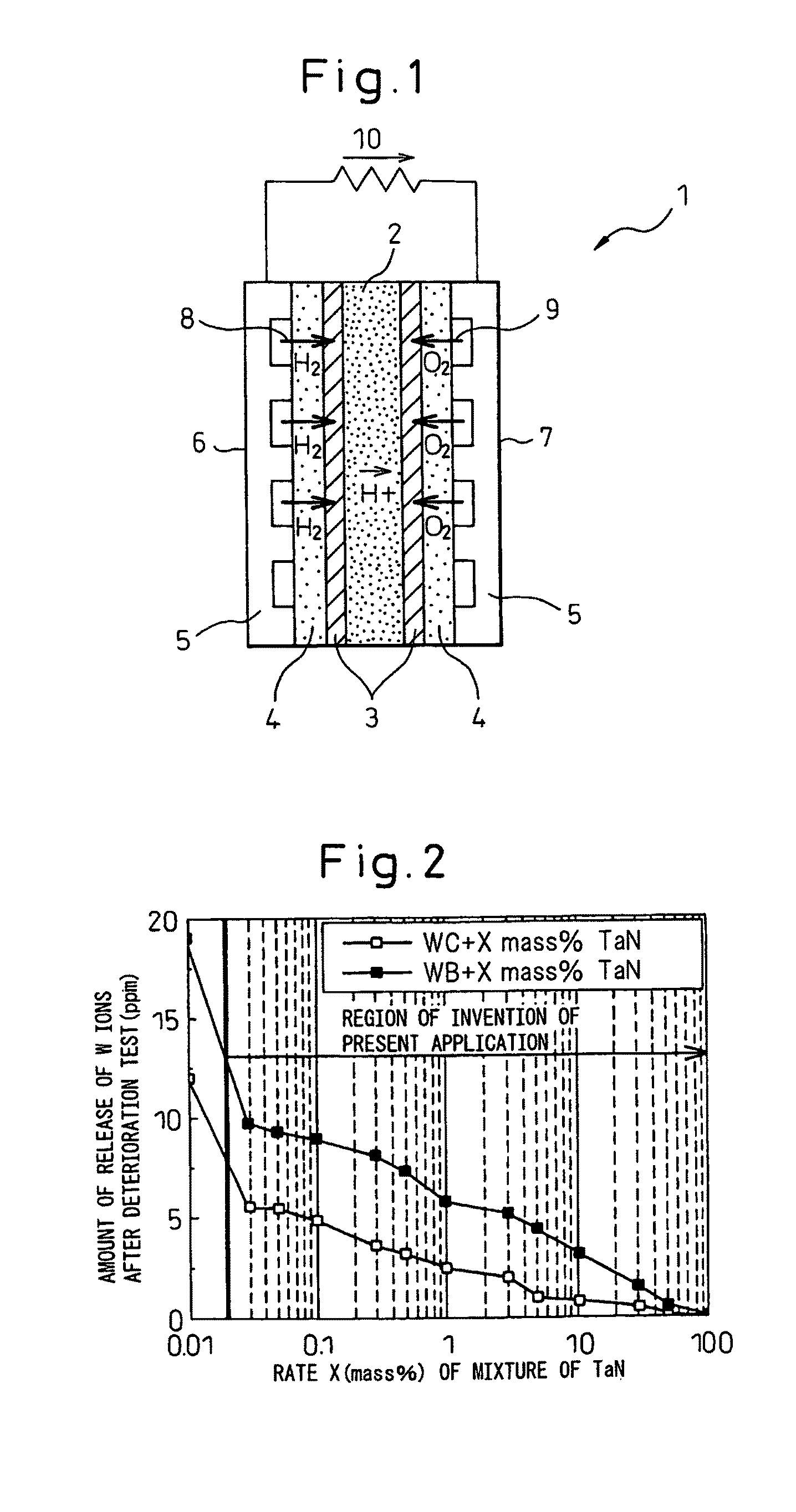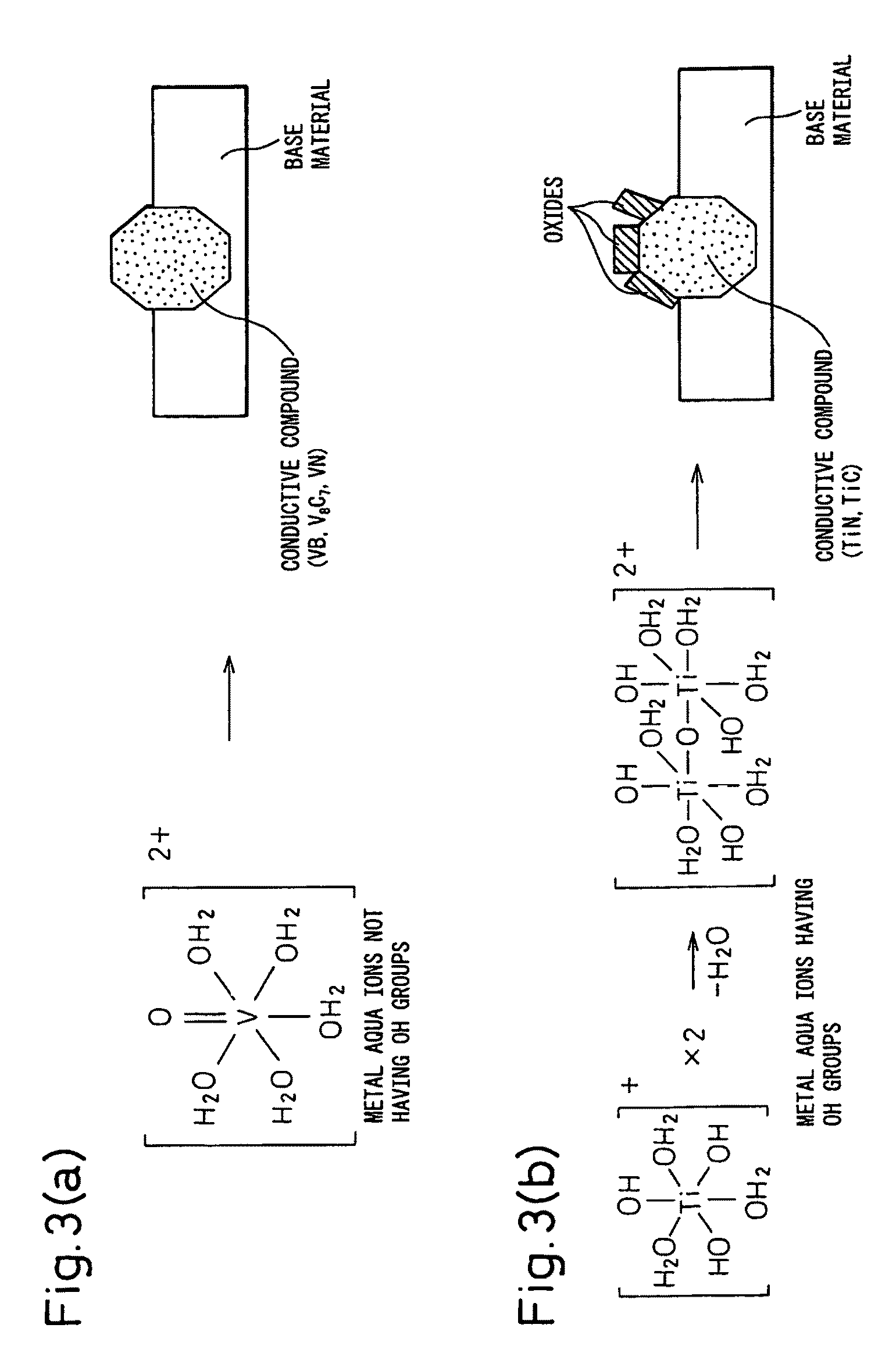Stainless steel, titanium, or titanium alloy solid polymer fuel cell separator and its method of production and method of evaluation of warp and twist of separator
a solid polymer fuel cell and separator technology, applied in the direction of cell components, final product manufacturing, sustainable manufacturing/processing, etc., can solve the problems of obstructing greater compactness, high cost, and development of breakage-resistant carbon-based separators, so as to reduce the cost and mass productivity, reduce the electromotive force, and reduce the cost
- Summary
- Abstract
- Description
- Claims
- Application Information
AI Technical Summary
Benefits of technology
Problems solved by technology
Method used
Image
Examples
examples
[0185]Below, examples will be used to explain the present invention in detail.
Example (1) to Example (20)
[0186]The means of the invention were used to treat stainless steel, titanium, or titanium alloy metal separators given surface relief shapes forming gas channels in 100 mm square regions and having flat parts at the four peripheries. Each material had an extremely thin sheet thickness of about 0.1 mm and is easily deformed by a relatively weak force. The stainless steel separators were shaped by rolling, while the titanium and titanium alloy separators were shaped by press forming.
[0187]Table 2 to Table 21 (Example (1) to Example (20)) also include comparative products. Examples of invention products of flat separators treated to become conductive by the blast method according to the invention of the present application are listed. By way of reference, the levels of inclusion of impurity elements in products of the present invention were all levels below the detection limit by e...
example
(20)
[0220]
TABLE 21BuriedWorkingConduciveWarp rateClassNo.MaterialmethodsubstanceWL1WL2WC1WC2WXCInvention86TitaniumPressingTaN: 20.0 mass %0.010.020.010.010.02alloyWC: 80.0 mass %6% Al—4% VInvention87TitaniumPressingTaN: 30.0 mass %0.010.010.010.010.01alloyWC: 70.0 mass %6% Al—4% VInvention88TitaniumPressingTaN: 40.0 mass %0.010.020.010.020.01alloyWC: 60.0 mass %6% Al—4% VInvention89TitaniumPressingTaN: 50.0 mass %0.010.010.010.010.02alloyWC: 50.0 mass %6% Al—4% VContactresistancewith carbonConductiveTwist rateRoughnesspaperIon releasesubtanceClassNo.TXLTXCprovision(mΩcm2)resistancecostRemarksInvention860.010.01◯6.5⊚⊚*86Invention870.010.01◯5.9⊚⊚*87Invention880.010.01◯9.8⊚⊚*88Invention890.010.01◯11⊚◯*89
(Remarks)[0221]*1 Average particle size 200 μm superhard WC particles driven by 0.5 MPa into entire surface of separator surface relief parts.[0222]*2 Average particle size 200 μm superhard WB particles driven by 0.5 MPa into entire
[0223]surface of separator surface relief parts.[0224]*...
example 21
[0311]High corrosion resistance stainless steel and titanium of a length of 50 mm, a width of 50 mm, and a thickness of 0.2 mm were used as base materials of the test materials. As conductive substance particles comprised of metal elements having at most one OH group bonded by metal aqua ions, ones comprised of VB, V8C7, VN, and their mixtures with average particle sizes of 5 μm to 50 μm coated on tungsten carbide superhard core particles with average particle sizes of 100 μm to 300 μm with a binder comprised of Cu mixed with the conductive substance in an amount of 1 wt % were driven into said test base material by a firing pressure of 0.3 MPa to 0.5 MPa to obtain test materials. Further, for comparison, TiN and TiC were driven into said test base materials as conductive substance particles having as ingredients metal elements having OH groups in the metal aqua ions by the blast method under similar conditions to obtain test materials.
[0312]After said blast treatment, the test mate...
PUM
| Property | Measurement | Unit |
|---|---|---|
| mean roughness | aaaaa | aaaaa |
| mean roughness | aaaaa | aaaaa |
| Ra | aaaaa | aaaaa |
Abstract
Description
Claims
Application Information
 Login to View More
Login to View More - R&D
- Intellectual Property
- Life Sciences
- Materials
- Tech Scout
- Unparalleled Data Quality
- Higher Quality Content
- 60% Fewer Hallucinations
Browse by: Latest US Patents, China's latest patents, Technical Efficacy Thesaurus, Application Domain, Technology Topic, Popular Technical Reports.
© 2025 PatSnap. All rights reserved.Legal|Privacy policy|Modern Slavery Act Transparency Statement|Sitemap|About US| Contact US: help@patsnap.com



